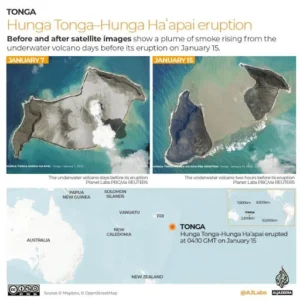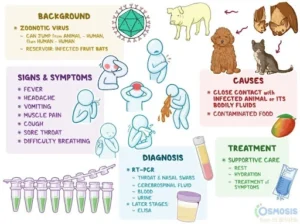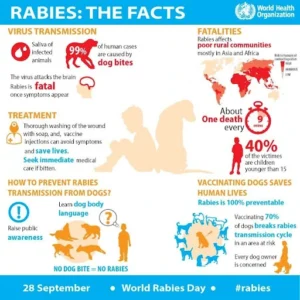UPSC GS 1
Hunga Ha’apai
- News: The 2022 eruption of the Hunga Tonga-Hunga Ha’apai (Hunga Tonga) volcano in Tonga is the subject of a recent study in the Journal of Climate, exploring its climate impacts.
- Geographic Location: The Hunga Tonga-Hunga Ha’apai (Hunga Tonga) volcano is a submarine stratovolcano located in the Tongan archipelago in the southern Pacific Ocean.
- Islands and Reefs: It encompasses the small islands of Hunga Tonga and Hunga Ha’apai, as well as shallow reefs along the caldera rim of a larger submarine edifice.
- Position in the Pacific: Situated west of the main inhabited islands in the Kingdom of Tonga, it is approximately 30 km south of the submarine volcano of Fonuafoʻou and 65 km north of Tongatapu, the country’s main island.

- Tectonic Setting: The volcano is part of the Tonga-Kermadec Islands volcanic arc, which is a highly active subduction zone extending from New Zealand north-northeast to Fiji.
-
- Subduction Zone Dynamics: This volcanic arc was formed due to the subduction of the Pacific Plate beneath the Indo-Australian Plate.
- Activity History: Hunga Tonga-Hunga Ha’apai has been erupting regularly over the past few decades, contributing to the dynamic volcanic activity in the region.
- What Is An Undersea Volcano?
-
- An undersea or submarine volcano is located below the ocean surface and mostly erupts under water.
- There are an estimated one million undersea volcanoes that, like continental volcanoes, are located near the Earth’s tectonic plates and where they form.
- These volcanoes not only deposit lava, but can also spew out large amounts of volcanic ash.
- Undersea volcanic activities give rise to seamounts – underwater mountains that are formed on the ocean floor but do not reach the water surface.
UPSC BASIC Foundation: Master NCERTs for IAS/IPS Exam Prep
UPSC GS 2
International Health Regulations (IHR) Amendments
- News: Member countries of the UN World Health Organization have adopted amendments to the International Health Regulations (IHR) at the 77th World Health Assembly.
- International Health Regulations (IHR):
-
- Definition: The IHR are an international legal agreement adopted by all member states of the WHO, authorized under Article 21 of the WHO Constitution.
- Aim: IHR defines countries’ responsibilities in managing public health events and emergencies with potential cross-border implications.
- Legality: The IHR is legally binding on 196 countries, including the 194 WHO Member States.
- IHR Amendments:
-
- Defining Pandemic Emergency: IHR shall include the introduction of a definition of a pandemic emergency for effective international collaboration in pandemics.
- Solidarity And Equity: Amendments emphasize solidarity and equity in accessing medical products and financing by establishing a Coordinating Financial Mechanism.
- States Parties Committee: There shall be a States Parties Committee to promote and support cooperation for effective IHR implementation.
- National IHR Authorities: Creation of National IHR Authorities will improve coordination of the Regulations within and among countries.
- 77th World Health Assembly (WHA):
-
- The Seventy-seventh World Health Assembly was held in Geneva, Switzerland, on 27 May – 1 June 2024.
- Theme: ‘All for Health, Health for All’.
- Role of WHA:
- The World Health Assembly is the decision-making body of the World Health Organization (WHO).
- The Assembly is attended by delegations from all WHO member States and focuses on a specific health agenda prepared by the Executive Board.
- Functions of WHA:
- To determine the policies of the WHO,
- Appoint the Director-General,
- Supervise financial policies, and review and approve the proposed programme budget.
- Meeting: The Health Assembly is held annually in Geneva, Switzerland.
International Air Transport Association (IATA)
- News: India will host the annual general meeting (AGM) of the International Air Transport Association (IATA), next year, after a gap of 42 years.
- Definition: The International Air Transport Association (IATA) is an international trade body founded in 1945 by a group of airlines.
-
- It is the successor to the International Air Traffic Association founded in Hague in 1919.
- Today, IATA represents 300 airlines comprising 94% of the international scheduled air traffic.
- Establishment: It was founded in Havana, Cuba, on 19 April 1945.
- Aim:
-
- Inter-airline cooperation in promoting safe, reliable, secure and economical air services.
- Supports many areas of aviation activity and help formulate industry policy on critical aviation issues, including environmental concerns.
- Headquarters: Montreal, Canada
Doctrine of Merger
- News: The Supreme Court recently held that the extraordinary powers under Article 142 of the Constitution of India are an exception to the doctrine of merger.
- Definition: The Doctrine of Merger is a common law doctrine founded on the principle of maintenance of decorum and propriety in the functioning of Courts and preserving the sanctity of the justice delivery system.
- Meaning: The Doctrine of Merger – To merge means to sink or disappear in something else, to become absorbed or extinguished.
- Implication: The doctrine of merger provides that when an appellate court passes an order, the order passed by the lower court is merged with that order.
-
- The underlying logic is that there cannot be more than one decree or operative order governing the same subject matter at a given point of time.
- Significance:
-
- The doctrine solves the issue of which order must be enforced and given importance if there are multiple orders passed by both subordinate and superior courts on a single issue.
- It clarifies and provides that in this situation, the order passed by the superior court would prevail and that the order of the lower court would be merged with the order passed by the superior court.
- It seeks to instill discipline in the functioning of subordinate adjudicating authorities, whether judicial, quasi-judicial, or administrative.
- Legality: The doctrine is not recognized statutorily
UPSC GS 3
Non-Infectious Nipah Virus-Like Particles
- News: Scientists at the Institute of Advanced Virology (IAV) have developed a novel way of generating non-infectious Nipah virus-like particles (VLPs) in the laboratory, which mimic the wild-type Nipah Virus (NiV).
- Overview of Virus-Like Particles (VLPs):
-
- Virus-Like Particles (VLPs) are non-infectious molecules that resemble viruses.
- They are valuable tools for studying viral behavior without the risk of causing disease.
- HiBiT-Tagged VLPs:
-
- The latest VLPs are enhanced with a small peptide called HiBiT.
- This tagging improves their functionality, making them particularly useful in drug screening and vaccine development.
- Vaccine Development:
-
- VLPs play a crucial role in developing vaccines for various diseases, including human papillomavirus (HPV), hepatitis B, and malaria.
- They are highly effective in eliciting a protective immune response.
- Immune Response Mechanism:
-
- Upon introduction into the body, VLPs stimulate an immune response without causing disease symptoms.
- This process effectively trains the immune system to recognize and combat the actual virus.
- Applications in Safer Research:
-
- VLPs enable scientists to test vaccines and treatments for the Nipah virus in labs with lower safety requirements (BSL-2
- This advancement makes the research process safer and more accessible.
- Use as Nanomachines:
-
- Recently, VLPs have been utilized as nanomachines to deliver drugs to specific sites and cells within the body, offering targeted and efficient treatment options.
- Structure and Function of Virus-Like Particles (VLPs):
-
- Size:
- VLPs are small, with a radius ranging from about 20 to 200 nm.
- This small size allows them to enter lymph nodes and effectively activate the immune system.
- Composition:
- VLPs are composed of one or more structural proteins, which may be arranged in multiple layers.
- Some VLPs include an outer lipid envelope that mimics the virus’s protective outer layer, enhancing their resemblance to actual viruses.
- Vaccine Production:
- VLP vaccines can be produced using various cell types, including bacterial, yeast, insect, or mammalian cells.
- These vaccines are known for their strong immune response due to the dense display of epitopes on the VLP surface.
- About Nipah Virus:
-
- Transmission:
- Nipah virus (NiV) is a zoonotic virus, meaning it can transmit from animals to humans.
- Transmission can occur through contaminated food or directly between people.
- Disease Impact:
- The Nipah virus can cause a wide range of illnesses in humans, from asymptomatic infections to acute respiratory problems and fatal encephalitis.
- It also causes severe disease in animals like pigs, which can significantly impact the economic stability of farmers.

-
-
- Treatment and Management:
- Currently, there are no specific drugs or vaccines available for treating the Nipah virus.
- Intensive supportive care is crucial for managing severe respiratory and neurological complications in individuals infected with the Nipah virus.
A List of Major Freedom Fighters of India (1857-1947)
Rabies
- News: The government of J&K has declared human rabies a notifiable disease.
- Definition: Rabies is a zoonotic viral disease caused by the RABV virus.
- Affected System:
-
- Central Nervous System: Rabies primarily attacks the central nervous system, leading to severe brain disease and ultimately resulting in death if treatment is not administered before symptoms appear.
- Transmission:
-
- Main Carriers: The primary carriers of the rabies virus to humans are domestic dogs, accounting for up to 99% of cases. The virus can also infect both domestic and wild animals.
- Mode of Spread: Rabies spreads through the saliva of infected animals, typically via bites, scratches, or direct contact with mucous membranes such as the eyes, mouth, or open wounds.
- Symptoms: Lethargy, fever, vomiting, anorexia, cerebral dysfunction, ataxia, paralysis, difficulties in breathing and swallowing, excessive salivation, unusual behaviour etc.
- Outcome: Once clinical symptoms appear, rabies is almost always fatal.

- Prevention:
-
- Rabies can be effectively prevented through vaccination.
- The most cost-effective strategy for preventing rabies in humans is to vaccinate dogs, including puppies, thereby cutting off the virus’s transmission at its source.
- Treatment:
-
- Post-Exposure Prophylaxis (PEP): After exposure to rabies, treatment includes thorough wound care, administration of human rabies immune globulin (HRIG), and a series of four or five rabies vaccines.
- Effectiveness: This post-exposure treatment is nearly 100% effective in preventing the disease if given promptly after exposure.
- What is a Notifiable Disease?
-
- Definition : A notifiable disease is any disease that must be reported to government authorities by law.
- Purpose: Reporting allows authorities to monitor the disease and provides early warning of possible outbreaks.
- Legal Requirements:
- The World Health Organization’s International Health Regulations, 1969 require disease reporting to the WHO for global surveillance and advisory purposes.
- Registered medical practitioners are required to report notifiable diseases:
- Within three days in written form.
- Verbally via phone within 24 hours, depending on urgency.
- Reporting Entities: Every government hospital, private hospital, laboratory, and clinic must report cases of the disease to the government.
- Process of Notification:
- Written Notification: For most diseases, healthcare providers must fill out a specific form detailing the case and submit it to local or state health authorities within three days.
- Verbal Notification: In urgent situations, healthcare providers are required to report cases verbally via phone within 24 hours.
- Electronic Reporting Systems: Some regions may use electronic health records and reporting systems to streamline the notification process.
- Benefits:
-
-
- Helps the government track diseases and formulate plans for elimination and control.
- Improves information about the burden and distribution of less infectious conditions.




